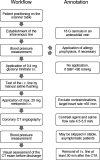Factors influencing the safety of outpatient coronary CT angiography: a clinical registry study
- PMID: 35940836
- PMCID: PMC9364403
- DOI: 10.1136/bmjopen-2021-058304
Factors influencing the safety of outpatient coronary CT angiography: a clinical registry study
Abstract
Objectives: Since the safety of coronary CT angiography (CTA) is of great importance, especially with regard to widening indications and increasing morbidity, the aim of this study was to assess influencing factors.
Methods: Patients undergoing coronary CTA in a third-generation dual-source CT in a radiological centre were included in a clinical registry. Up to 20 mg metoprolol was administered intravenously to attain a heart rate ≤65/min. Glyceryl trinitrate (GTN) was administered in doses of 0.8 mg and 0.4 mg. Blood pressure was measured before the administration and after the CTA.
Results: Out of 5500 consecutive patients (3194 men, 62.3 (54.9-70.0) years), adverse events occurred in 68 patients (1.2%) with mild anaphylactoid reactions (0.4%), vasovagal symptoms (0.3%) and extravasation (0.3%) being most frequent. Anti-allergic drugs were given in 17 patients, atropine in 3 patients and volume in 1 patient. Drug administration resulted in a significant mean arterial pressure decline (96.0 (88.3-106.0) vs 108.7 (99.7-117.3) mmHg; p<0.001). Patients who suffered systolic blood pressure drops >20 mmHg or >40 mmHg were older (66.5 (58.6-73.3) vs 60.5 (53.6-68.3) years; 70.2 (63.3-76.5) vs 62.1 (54.7-69.6) years), more often male (65.1% vs 54.4%; 68.9% vs 57.3%) and had higher Agatston score equivalents (83.0 (2.0-432.0) vs 15.0 (0.0-172.0); 163.0 (16.3-830.8) vs 25.0 (0.0-220.0); all p<0.001). GTN dose reduction lowered the fraction of patients suffering from blood pressure drops >20 mmHg or >40 mmHg from 34.5% to 27.4% and from 6.1% to 3.5% (both p<0.001), respectively. The proportion of coronary segments with impaired image quality did not differ significantly.
Conclusions: Coronary CTA with intravenous beta-blocker administration is a safe procedure in an outpatient setting as adverse events are rare and mostly mild. Reduced GTN doses can further improve safety by lowering the rate of significant blood pressure drops, which occurred especially in elderly men with increased plaque burden.
Trial registration number: NCT03815123.
Keywords: Adverse events; CLINICAL PHARMACOLOGY; Cardiology; Cardiovascular imaging; Computed tomography; Coronary heart disease.
© Author(s) (or their employer(s)) 2022. Re-use permitted under CC BY-NC. No commercial re-use. See rights and permissions. Published by BMJ.
Conflict of interest statement
Competing interests: None declared.
Figures




Similar articles
-
Influence of irregular heart rhythm on radiation exposure, image quality and diagnostic impact of cardiac computed tomography angiography in 4,339 patients. Data from the German Cardiac Computed Tomography Registry.J Cardiovasc Comput Tomogr. 2018 Jan-Feb;12(1):34-41. doi: 10.1016/j.jcct.2017.11.006. Epub 2017 Nov 21. J Cardiovasc Comput Tomogr. 2018. PMID: 29195843
-
Comparison of different strategies of ivabradine premedication for heart rate reduction before coronary computed tomography angiography.J Cardiovasc Comput Tomogr. 2014 Jan-Feb;8(1):77-82. doi: 10.1016/j.jcct.2013.12.005. Epub 2014 Jan 9. J Cardiovasc Comput Tomogr. 2014. PMID: 24582046 Clinical Trial.
-
Coronary CT angiography with 80 kV tube voltage and low iodine concentration contrast agent in patients with low body weight.J Cardiovasc Comput Tomogr. 2016 Jul-Aug;10(4):322-6. doi: 10.1016/j.jcct.2016.06.003. Epub 2016 Jun 15. J Cardiovasc Comput Tomogr. 2016. PMID: 27357327
-
Esmolol is noninferior to metoprolol in achieving a target heart rate of 65 beats/min in patients referred to coronary CT angiography: a randomized controlled clinical trial.J Cardiovasc Comput Tomogr. 2015 Mar-Apr;9(2):139-45. doi: 10.1016/j.jcct.2015.02.001. Epub 2015 Feb 14. J Cardiovasc Comput Tomogr. 2015. PMID: 25819196 Clinical Trial.
-
Coronary computed tomographic imaging in women: An expert consensus statement from the Society of Cardiovascular Computed Tomography.J Cardiovasc Comput Tomogr. 2018 Nov-Dec;12(6):451-466. doi: 10.1016/j.jcct.2018.10.019. Epub 2018 Oct 23. J Cardiovasc Comput Tomogr. 2018. PMID: 30392926 Review.
Cited by
-
Coronary Computed Tomography vs. Cardiac Magnetic Resonance Imaging in the Evaluation of Coronary Artery Disease.Diagnostics (Basel). 2022 Dec 30;13(1):125. doi: 10.3390/diagnostics13010125. Diagnostics (Basel). 2022. PMID: 36611417 Free PMC article. Review.
-
Reliability of cardiac computed tomography examination in cardiac pathology - a case series and literature review.J Med Life. 2023 Jul;16(7):1140-1146. doi: 10.25122/jml-2023-0268. J Med Life. 2023. PMID: 37900066 Free PMC article. Review.
-
Human AI Teaming for Coronary CT Angiography Assessment: Impact on Imaging Workflow and Diagnostic Accuracy.Diagnostics (Basel). 2023 Nov 30;13(23):3574. doi: 10.3390/diagnostics13233574. Diagnostics (Basel). 2023. PMID: 38066814 Free PMC article.
-
Measurement of Retrobulbar Blood Flow and Vascular Reactivity-Relevance for Ocular and Cardiovascular Diseases.Diagnostics (Basel). 2023 Nov 23;13(23):3514. doi: 10.3390/diagnostics13233514. Diagnostics (Basel). 2023. PMID: 38066755 Free PMC article. Review.
References
-
- Williams MC, Newby DE, Dey D, et al. . Response by Williams et al to Letter Regarding Article, “Low-Attenuation Noncalcified Plaque on Coronary Computed Tomography Angiography Predicts Myocardial Infarction: Results From the Multicenter SCOT-HEART Trial (Scottish Computed Tomography of the HEART)”. Circulation 2020;142. 10.1161/CIRCULATIONAHA.120.049840 - DOI - PubMed
Publication types
MeSH terms
Substances
Associated data
LinkOut - more resources
Full Text Sources
Medical
